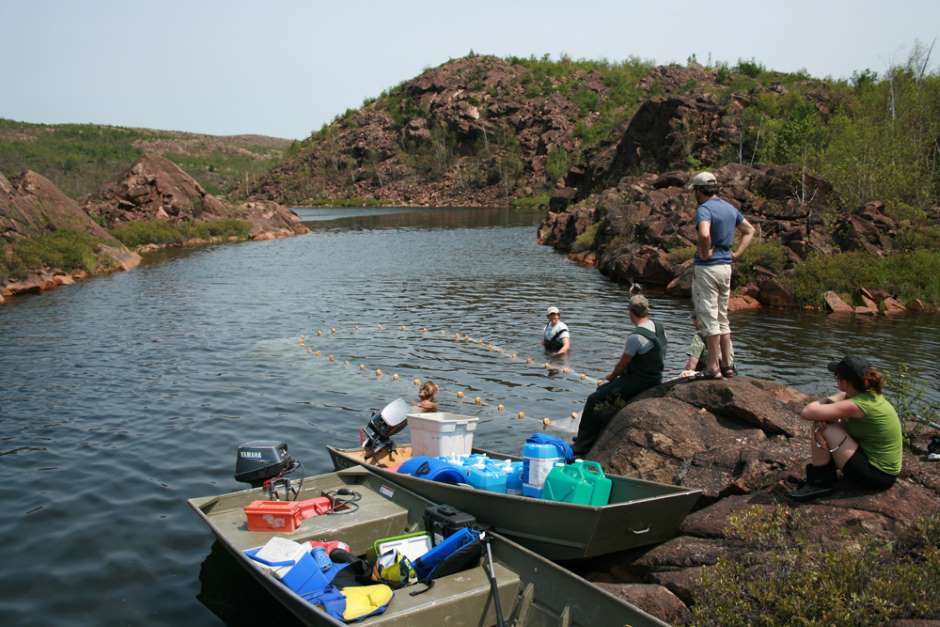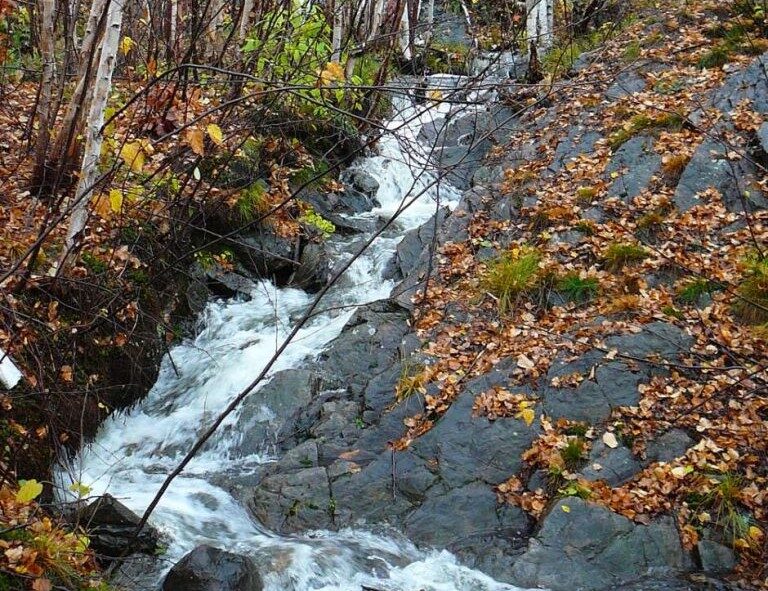Study: Forested Watersheds Make More Fish Food
 Young-of-the-year yellow perch are caught with a seine net in a nearshore site at Daisy Lake, Sudbury, Ontario. (Credit: Andrew Tanentzap)
Young-of-the-year yellow perch are caught with a seine net in a nearshore site at Daisy Lake, Sudbury, Ontario. (Credit: Andrew Tanentzap)Daisy Lake is an idyllic landscape: A quiet lake, two miles long and a tenth of that in width, resting between the forested slopes of Northern Ontario. The scenic location of the lake is what led it to be chosen as a research site for a 2014 study looking at the effects of forest cover and loss on lake fish.
“The driving question in our mind was, ‘What’s going to happen when land changes?’” said Andrew Tanentzap, lead author of the study and a lecturer at the University of Cambridge.
Land use is an important consideration in terms of protecting the ecosystem and the biodiversity there. In particular, forested watersheds and water bodies are defined by the health of the surrounding woods. Debris from the trees falls into the water, becoming food for the fish and smaller organisms in the system—enriching the water with vital nutrients.
Fish Food and Forested Watersheds
Daisy Lake wasn’t always so pristine—years of logging and forest fires have left a scar on the land, leading to a retreating tree line along the lake’s shores. Nickel mining scarred the earth, turning it ashen with slag. Over the past 30 years, the lake and surrounding forest have been the focus of various restoration efforts.
The yellow perch inhabiting its waters noticed the changes, too, though only now are scientists beginning to understand the extent to which those fish were affected.
“If you pick up a fish from our lake, about a third of it is made up of tree leaves,” Tanentzap said. “That increases up to 70 percent as more of the surrounding landscape becomes forested.”
“That’s pretty surprising,” he mused.
Such observations affirm just how interconnected ecosystems are, illustrating the fragility of the food chain in how a single variable loss or displacement can change environmental systems and the life inhabiting them.
How Terrestrial Debris Creates Food
The conversion of land resources into aquatic food sources can begin as simply as a leaf falling from a nearby tree into a nearby lake or stream. This reliance on terrestrial debris is one of the main reasons the loss of the surrounding forest was such a concern for Daisy Lake and the surrounding watershed, as the receding woods would inevitably lead to a loss of food sources.
“When all this organic matter accumulates… it provides an energy source for many bacteria that live in the water,” Tanentzap said. “It gives them energy to metabolize.” Essentially, the zooplankton eat the bacteria and are then eaten by hungry fish. The researchers found that more organic debris means more bacteria, more zooplankton and bigger perch thanks to a healthier food source.
And bigger perch are better perch. “They’re going to survive winter better, they’re going to be able to escape predation, and those populations are going to be able to better reproduce,” Tanentzap said.
Several qualities make yellow perch particularly useful to study. They are a widespread species found throughout North America and with relatives in Europe. Yellow perch are significant in sport and commercial fishing, and in larval form, they display a close affinity to the nearshore habitat where much of the debris collects. And besides, Tanentzap noted, “they’re kind of the main fish in this lake that we worked on.”

Small forest stream draining one of the study catchments in Daisy Lake, Sudbury, Ontario. (Credit: Erik Szkokan-Emilson)
Conclusion
The scientists quantified the effects of terrestrial debris on the perch in forested watersheds by measuring the elemental mass in the fish compared to the mass of specific elements found in different food sources. “By measuring the same elements in fish, we can work out how much of that fish was derived from each one of these sources,” Tanentzap said.
Zooplankton have always been presumed to be important in terms of aquatic system health, but the results of the study affirm that they are critical chains in the ecological web. Algae were the only known food source for zooplankton until recently, but the new discovery reveals the importance of terrestrial nutrition in aquatic ecosystems.
“It’s not necessarily that fish will starve without forests around them,” Tanentzap said. “What we’re showing here is that as you add extra food on top of that baseline level of nutrition, then it’s going to make individuals fatter and larger.”
“And that’s important,” continues Tanentzap, particularly in terms of how resource managers ensure the recruitment of critical or struggling populations. Many of these species are threatened in the earlier stages of life as they’re more fragile, and a surplus of food can make a difference in the overall health of these species that would otherwise struggle to survive in a highly-competitive environment with limited food sources.



0 comments